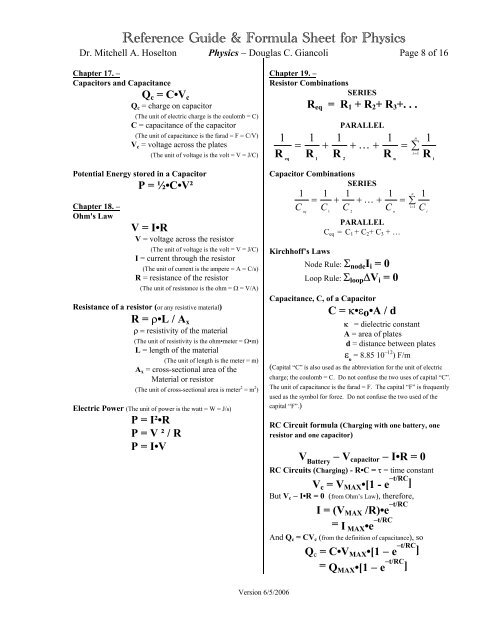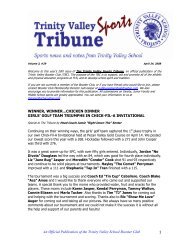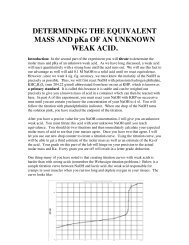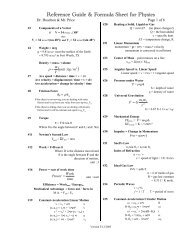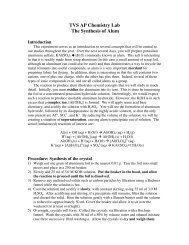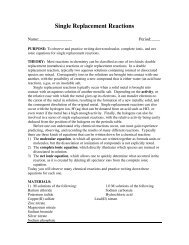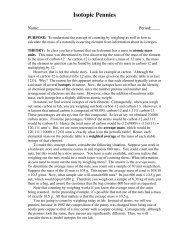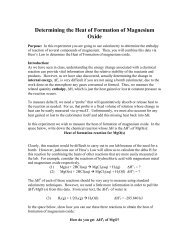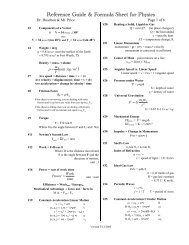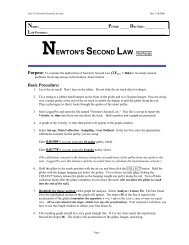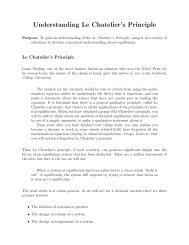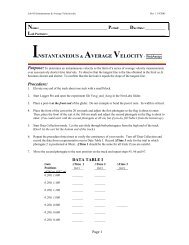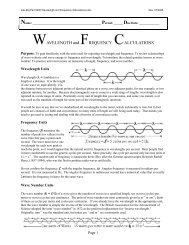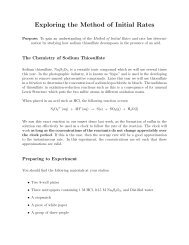Reference Guide & Formula Sheet for Physics - 2006 Version
Reference Guide & Formula Sheet for Physics - 2006 Version
Reference Guide & Formula Sheet for Physics - 2006 Version
You also want an ePaper? Increase the reach of your titles
YUMPU automatically turns print PDFs into web optimized ePapers that Google loves.
<strong>Reference</strong> <strong>Guide</strong> & <strong>Formula</strong> <strong>Sheet</strong> <strong>for</strong> <strong>Physics</strong><br />
Dr. Mitchell A. Hoselton <strong>Physics</strong> − Douglas C. Giancoli Page 8 of 16<br />
Chapter 17. –<br />
Capacitors and Capacitance<br />
Q c = C•V c<br />
Q c = charge on capacitor<br />
(The unit of electric charge is the coulomb = C)<br />
C = capacitance of the capacitor<br />
(The unit of capacitance is the farad = F = C/V)<br />
V c = voltage across the plates<br />
(The unit of voltage is the volt = V = J/C)<br />
Chapter 19. –<br />
Resistor Combinations<br />
SERIES<br />
R eq = R 1 + R 2 + R 3 +. . .<br />
1<br />
R<br />
eq<br />
=<br />
1<br />
R<br />
1<br />
+<br />
1<br />
R<br />
PARALLEL<br />
2<br />
+ K +<br />
1<br />
R<br />
n<br />
=<br />
n<br />
∑<br />
i=<br />
1<br />
1<br />
R<br />
i<br />
Potential Energy stored in a Capacitor<br />
P = ½•C•V²<br />
Chapter 18. –<br />
Ohm's Law<br />
V = I•R<br />
V = voltage across the resistor<br />
(The unit of voltage is the volt = V = J/C)<br />
I = current through the resistor<br />
(The unit of current is the ampere = A = C/s)<br />
R = resistance of the resistor<br />
(The unit of resistance is the ohm = Ω = V/A)<br />
Resistance of a resistor (or any resistive material)<br />
R = ρ•L / A x<br />
ρ = resistivity of the material<br />
(The unit of resistivity is the ohm•meter = Ω•m)<br />
L = length of the material<br />
(The unit of length is the meter = m)<br />
A x = cross-sectional area of the<br />
Material or resistor<br />
(The unit of cross-sectional area is meter 2 = m 2 )<br />
Electric Power (The unit of power is the watt = W = J/s)<br />
P = I²•R<br />
P = V ² / R<br />
P = I•V<br />
Capacitor Combinations<br />
SERIES<br />
1<br />
=<br />
1<br />
Kirchhoff’s Laws<br />
1<br />
+<br />
C<br />
1<br />
+ K +<br />
C<br />
PARALLEL<br />
C eq = C 1 + C 2 + C 3 + …<br />
Node Rule: Σ node I i = 0<br />
Loop Rule: Σ loop ∆V i = 0<br />
Capacitance, C, of a Capacitor<br />
C = κ•εo•A / d<br />
n 1<br />
= ∑<br />
i =<br />
C<br />
1<br />
C C<br />
eq<br />
1<br />
2<br />
n<br />
κ = dielectric constant<br />
A = area of plates<br />
d = distance between plates<br />
ε o<br />
= 8.85 10 −12 ) F/m<br />
(Capital “C” is also used as the abbreviation <strong>for</strong> the unit of electric<br />
charge; the coulomb = C. Do not confuse the two uses of capital “C”.<br />
The unit of capacitance is the farad = F. The capital “F” is frequently<br />
used as the symbol <strong>for</strong> <strong>for</strong>ce. Do not confuse the two used of the<br />
capital “F”.)<br />
RC Circuit <strong>for</strong>mula (Charging with one battery, one<br />
resistor and one capacitor)<br />
V Battery<br />
− V capacitor − I•R = 0<br />
RC Circuits (Charging) - R•C = τ = time constant<br />
V c = V MAX •[1 - e −t/RC ]<br />
But V c − I•R = 0 (from Ohm’s Law), there<strong>for</strong>e,<br />
I = (V MAX /R)•e −t/RC<br />
= I MAX•e −t/RC<br />
And Q c = CV c (from the definition of capacitance), so<br />
Q c = C•V MAX •[1 − e −t/RC ]<br />
= Q MAX •[1 − e −t/RC ]<br />
i<br />
<strong>Version</strong> 6/5/<strong>2006</strong>


